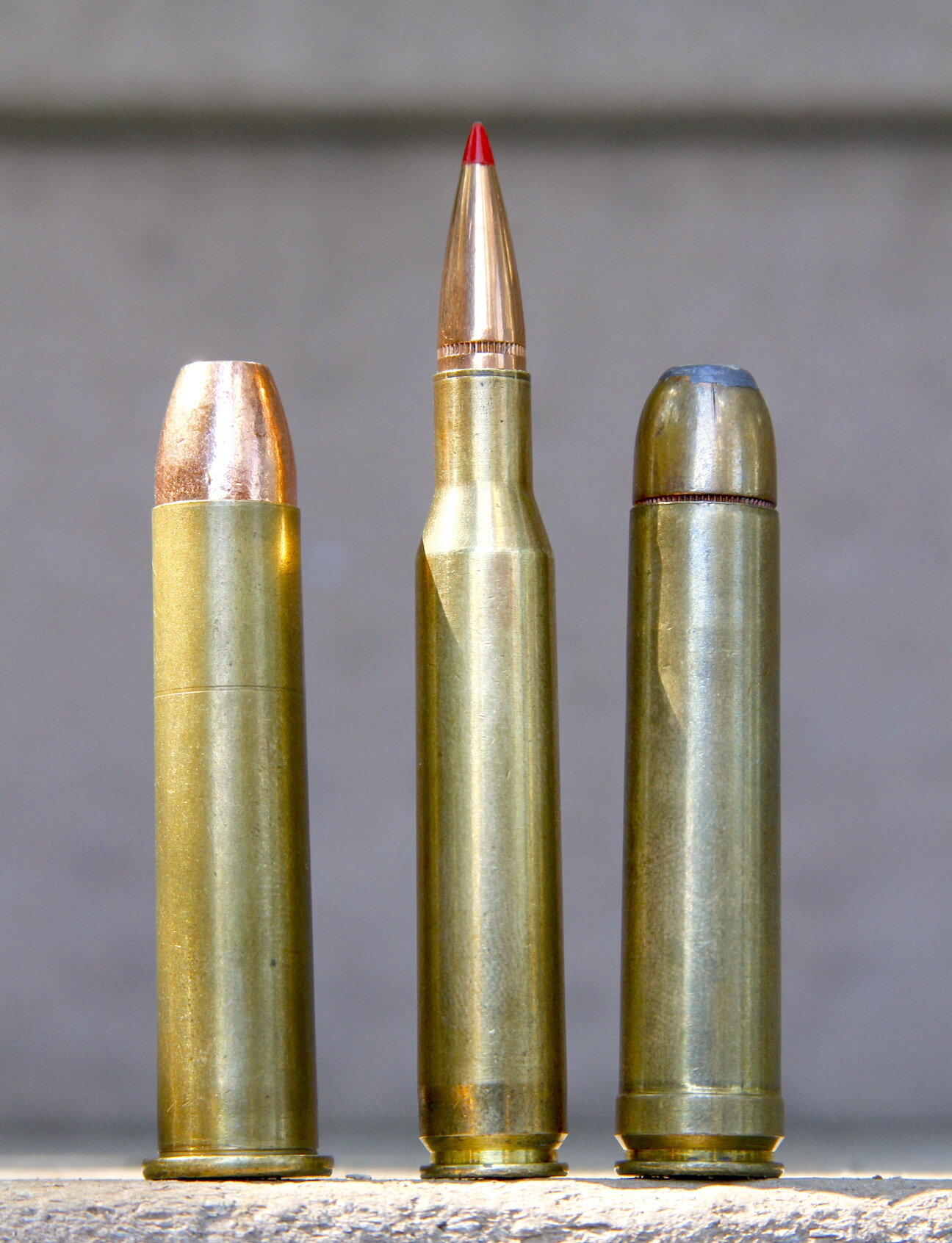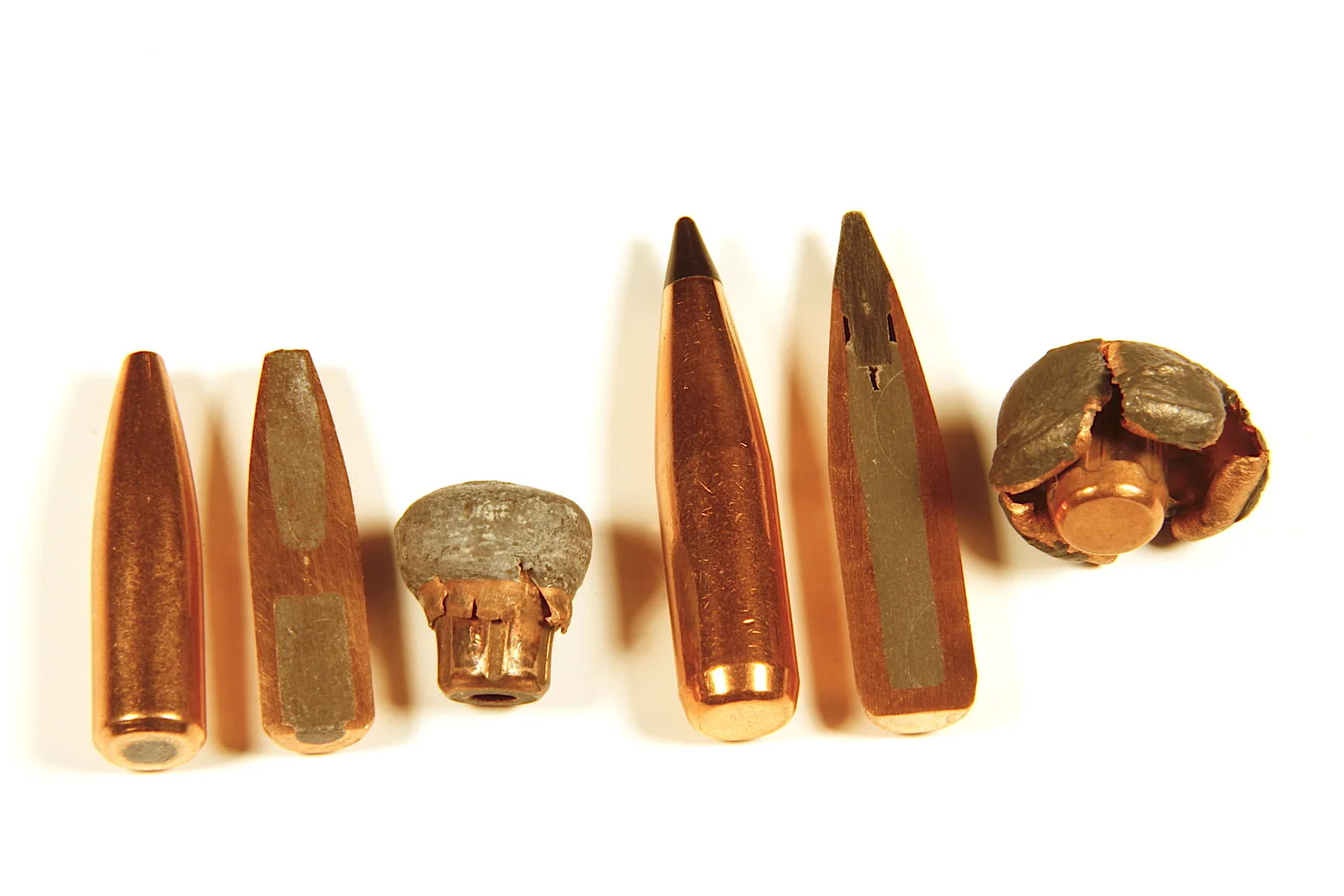Why Wind Bucking Bullets Are a Waste
by Ron Spomer
Wind bucking bullets are bad.
We hunters often brag about “wind bucking” bullets. We shouldn’t. Bullets that buck the wind hit their targets with less energy. They also drop excessively and deflect more in crosswinds.
The 500-grain hard-cast lead bullets topping these 45-120 Sharps buffalo cartridges look like wind bucking bullets — and they are. But that means they’re wasting their energy and getting deflected by the wind more than would the same weight bullet with a longer, sharply tipped nose.
Jumping to Conclusions Over Wind Bucking Bullets
Before you jump to conclusions and call me the things people call me when they jump to conclusions, I invite you to read my reasoning and see if it doesn’t make sense. Because, according to reasonably intelligent people like Sir Isaac Newton, it does. Unless we like poor exterior ballistic performance and weak terminal performance, we should consider bullets that SLIP wind, not buck it.
The oft-stated reason for wanting a big, wind bucking bullet is to minimize wind drift (more accurately called wind deflection.) This is a good objective but the wrong means for reaching it. Bullets that buck the wind drift more than those that slip it, even if total bullet weight is identical.
Confused? I was too. For years. Back in the day Dad used to buck hay with a big hay buck on the front of the John Deere. Then we went to bucking hay bales for $3.00 an hour. Lifting 30- to 50-pound bales overhead was WORK. Built up teen shoulders, but burned a lot of burgers and fries doing it.
Bucking hay bales in the 1970s was a lot of work requiring lots of energy constantly resupplied. Burgers and fries, man! Alas, once a “wind bucking” bullet is launched, it gets no additional fuel. The more wind it bucks, the weaker it gets. (No, this is not me or my friends.)
We did more bucking when we drove our big, red grain trucks to town in a typical 30 mph Dakota zephyr. Those old Y-block Ford V-8s chugged and whined while pushing blunt-nosed trucks into that head wind. Grain dust and sometimes the grain itself trailed in our wake.
So, when my hunting mentors began talking about big, flat-nosed and round-nosed, heavy-for-caliber bullets for bucking the wind, I was all over it. Yeah! A powerful bullet to do the heavy lifting. A fire plug of a bullet to muscle the wind right out of the way!
We Were Wrong About Wind Bucking Bullets
Wrong. We were all wrong. Bucking wind is fine if you have an engine and fuel to power it. But bullets do not. We push them with rapidly expanding gas. Once free of the barrel, the gasses are gone (BANG!) and those bullets are coasting. As anyone who’s ever ridden a bicycle can tell you, coasting into a headwind is an effort in losing. You lose speed, lose energy, and if a gust catches you slightly from the side, you can lose your balance and tip right over. A bullet fired at 3,000 fps is bucking a 2,045 mile-per-hour headwind!
The flat-nosed bullets on the 45-70 Govt. cartridge at left and the 450 Marlin at right look like what friends and I would have called great wind bucking bullets back in the day. Most of us now know the sleeker, sharply tipped, wind slipping bullet atop the 270 Win. is the better option for minimizing wind deflection and maximizing downrange energy.
To slip headwinds, smart bicyclists lean forward and tuck their arms in. Bullets should do the same. Instead of wide, blunt, and powerful looking, they should be long, lean, sleek, pointy and racy looking. Because the less they drag, the straighter they fly and the harder they hit.
All of this seems pretty obvious when stated this way, so how did we arrive at describing our attempts to minimize wind deflection and maximize bullet wallop as “bucking the wind?” Probably from what debaters would call a poor “definition of terms.” We thought we knew what bucking meant. We thought we knew that a big, heavy bullet — like a rock instead of a marshmallow on the picnic table — would be least blown off course by the wind.
Definitions R-Us
Should have paid more attention in physics class. I didn’t. I skipped physics out of fear of studying. Industrial arts was more fun. We got to bring our guns to school to refinish their walnut stocks. In the hundred or so years of that school’s history, no one was shot. But I digress. Back to physics class.
Back to Physics — Wind Ain’t Nuthin
What the smart kids were learning while I was sanding and varnishing was that drag is a drag. The atmosphere might seem like airy fairy nothing, but there’s that bike pedaling experience. And then a tornado blew the brick Lutheran Church to rubble… Maybe wind bucking bullets weren’t all they were cracked up to be. At 200 mph, tornadoes are fast, but not 2,045 mph bullets-in-the-wind fast.
The winds in a 200 mph tornado are powerful indeed, but nowhere near the 2,000 mph winds ripping at a bullet sent downrange at 3,000 fps.
Obviously, then, bullets are being slowed by the wind. Despite their narrow diameters. The easiest way to minimize this is the bike racer technique: Get sleek and narrow. The easiest way to judge a bullet that does this is by noting its Ballistic Coefficient number. B.C. predicts drag resistance. It’s a mathematical rating of a projectile’s ability to resist drag. The higher the B.C. number, the less the bullet will drag.
By now most of us know what high B.C. looks like. Long, sharp, sleek, boat-tailed. Heavy helps too. Mass is an important component of B.C. But it has to be shaped like a racer, not a puncher. It’s the efficient shape we expect from any fast animal or machine. The torpedo-like shape of a diving falcon, a racing porpoise, and streaking missile.
Even though half their length is hidden within the cartridge neck, the wind-slipping versus wind-bucking shapes of these 300 Win. Mag. bullets are pretty obvious. Both will hit hard enough to terminate big game inside of 200 yards, probably 400 yards, but the round nose will carry significantly less energy than the spire point and be deflected much farther in crosswinds.
Let’s Compare Trajectories
Stand a Hornady 180-grain .308 Round Nose (B.C. .241) beside a 178-grain ELD-X and you’ll see the difference. Both have the same Sectional Density (.271) and both can be fired at the same MV of 3,000 fps from a 300 Win. Mag. Zero both at 250 yards and, in a 10 mph crosswind, the Round Nose at 300 yards will drop about 1.2 inches more than the ELD-X. It will be deflected 7 inches more in that wind. And it will carry 868 foot-pounds LESS ENERGY. The ballistic charts below tell the tale. Study them and you’ll start to appreciate the shortcomings of wind bucking bullets.
300 Win. Mag., 180-gr. Round Nose, B.C. .241, 3,000 fps
300 Win. Mag., 180-gr. BTSP Interbond, B.C. .480, 3000 fps
When Blunt and Inefficient Don’t Matter
Give this reality, why do some of us cling to round nose bullets? Probably because many of us are convinced they “hit harder” than spire points. Of course, we’ve already shown they do not, so why do we embrace the opposite opinion? Perhaps because most round nose bullets are applied to game at 200 yards or closer.
At 200 yards the aforementioned round nose .308 bullet is still packing 2,042 foot-pounds of energy, more than enough to reach the vitals on deer, bear, elk, and even moose. This is 800 f-p less than the boat tail spire point, but some hunters feel that a blunt, round nose bullet delivers more wallop than the sharply tipped bullet. Appearances suggest that. Life experience suggests that. But I can’t find any objective evidence to prove it.
The usual explanation for the harder-hitting shape of the round nose (and flat-nose) is that the larger surface area makes the difference. Sounds right, but when you think of the speed at which a bullet hits… This 308 round nose we’re investigating is flying 1,550 mph at 200 yards. The ELD-X is ripping along at 1,812 mph. At those impact velocities, I have a hard time believing the initial nose shape is going to remain that way long enough to make a difference. The incredible violence of a bullet striking game flattens and often mangles bullets to such a degree that their starting shape would seem to matter little if at all.
Mushroomed, expanded, mangled, broken. Call it what you will, but the transformation of various bullets upon striking game seems so fast and so unpredictable that I have trouble imagining what a rounded or flattened nose could contribute to compensate for the hundreds of foot-pounds of energy sacrificed to their wind bucking shape.
More significant would be the materials and construction. Thin, brittle gilding metal jackets are more liable to break up than thicker and/or more malleable copper jackets. Bonded lead should adhere to the jacket and retain more mass for deeper penetration. Partition walls, copper shanks, and other hybrid constructions would more or less change mushrooming and surface area as bullets continue plowing forward. But a significant advantage starting with a round nose instead of sharply tipped? While sacrificing 500 f-p or more energy? Just doesn’t sound logical.
Faith Over Logic
Nonetheless, there are plenty of shooters who swear by the power of the round nose because they’ve seen it, sometimes again and again. I won’t try to dissuade them because faith is a powerful thing. If you believe in a round nose and it works for you, embrace it. Just be aware that it is giving up much, much more of its initial energy than is a sleeker, more drag resistant bullet.
The 500-grain Round Nose bullet with a wide meplat (flat tip) retained more than enough juice to impress this Comstock Lodge, NE, bison bull back in the late 1990s. Rifle was a Cabela’s Sharps replica chambered for the 45-120 Sharps cartridge. Hard cast bullets custom loaded by Superior Ammunition of Sturgis, SD.
One more suggestion: don’t make the mistake of assuming sharp-nosed, boat tail bullets are less strongly constructed than flat- and round-nose bullets. A high B.C. shape can be built around bonded, partitioned, thickly jacketed, hard-lead core bullets, too. All-copper hollow points can be engineered to open dramatically and widely while retaining 90% to as much as 100% of their mass for deep, bone crushing penetration, too, peeled back petals ripping and tearing and they tumble and spin.
The materials and construction of the Swift A-Frame and sharply-tipped Scirocco are engineered to expand reliably while retaining maximum weight during impact. If a sharp tip and sleek nose reduce expansion and frontal area, this spent Scirocco sure doesn’t show it.
Thinking back to my hay bucking days again, it strikes me that my old mentors were right. A big, heavy bullet does buck a lot of wind, but in the end the wind always wins. The bullet starts with only so much energy. The more is burns while fighting the wind, the faster it drops and the farther it “drifts” in crosswinds on its way to a target.
The moral of the story? Don’t buck the wind. Slip it.
# # #















